#film noir foundation
Text

Happy Halloween!
36 notes
·
View notes
Text
Mary Mallory / Hollywood Heights: Noir City Returns to Egyptian Theatre
Lizabeth Scott in Desert Fury (1947), showing March 24 as part of Noir City Hollywood.
The Film Noir Foundation celebrates the 25th Anniversary of Noir City Hollywood with a return to Hollywood’s beautiful restored Egyptian Theatre March 22 through 31, demonstrating that “Darkness Has No Borders” with a look at sinister, shadowy crime around the world. Several of the screenings include…
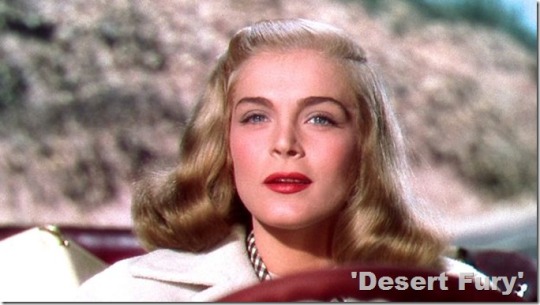
View On WordPress
0 notes
Photo
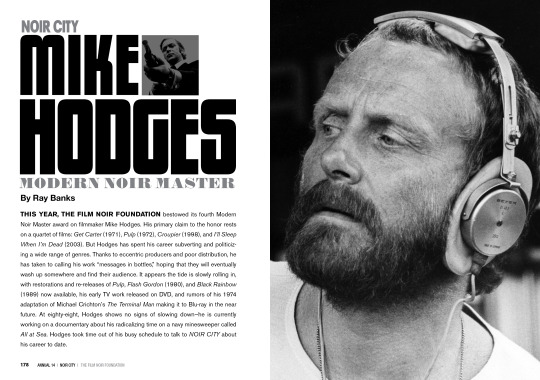
Never stops being a thrill having something picked for the Noir City annual (available August 2022), and it’s an even bigger thrill when that something happens to be my interview with Mike Hodges, in which we discuss not only The Big Four, but also his exemplary early TV work and later novels.
1 note
·
View note
Text
William Holden out of the shadows in Noir City
William Holden out of the shadows in Noir City
I am a big fan of NOIR CITY Magazine. The magazine is dedicated to film noir. The latest issue focuses on matinee idol William Holden. You can buy your issue directly from Amazon.
The latest issue of NOIR CITY is a beauty! However you look at it, the magazine is spectacular, featuring the electrifying combination of insightful writing and inspired graphic design we proudly consider our standard.…

View On WordPress
1 note
·
View note
Text
The Beast Must Die (Viñoly Barreto, Argentina, 1952)
THE BEAST MUST DIE (1952) is another fabulous rescue mission from Flicker Alley and The Film Noir Foundation. An adaptation of a detective novel by Cecil Day Lewis – Daniel’s father – under the pseudonym of Nicholas Blake, the fourth novel in the Strangeways series. The beast is a rich industrialist who beats his wife, abuses his stepchild, and is openly having an affair with his business…
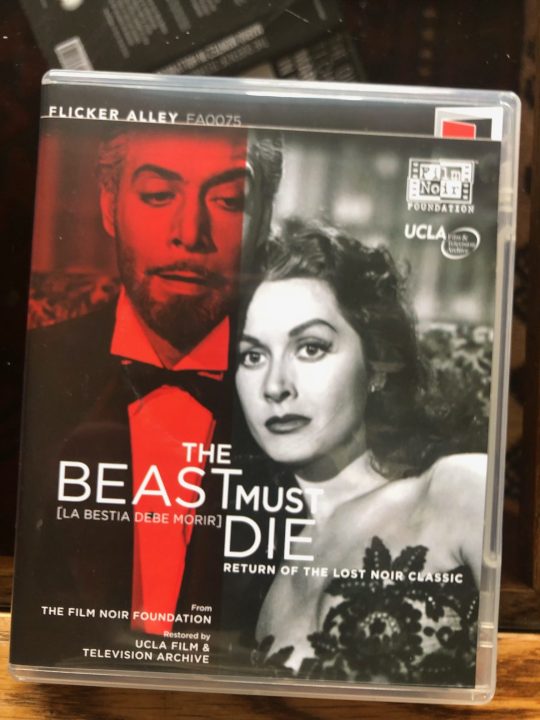
View On WordPress
#Argentine noir#Cecil Day Lewis#Claude Chabrol#Flicker Films#La bestia debe morir#Nicholas Blake#The Beast Must Die#The Film Noir Foundation#Viñoly Barreto
0 notes
Text
Terrible Visions
A scrambled timeline is a timeline that has proceeded much like ours, except that some particular facet has been mixed up all over the place. For example, in the scrambled timeline we will consider today, our world's fictional stories have been told by different people, and in different ways.
Bryan Lee O'Malley, in this alternate timeline, is best known as the cartoonist responsible for Homestuck, a popular comic series about a group of children who become embroiled in a cosmic-scale video game known as Sburb. Although Homestuck is probably most often associated with the cult classic Edgar Wright-directed film adaptation released in 2016, the comics themselves are highly-regarded, and the film brought a new audience to them. Netflix has commissioned an animated continuation, The Homestuck Epilogues, which is due to be released soon.
Andrew Hussie, on the other hand, is a figure you're likelier to know if you're overly online. His "MS Paint Adventures" series - most notably including Scott Pilgrim Vs The World, which is kind of like Homestuck but weirder and hornier - have firmly remained a fixture of obsessive Twitter fandom culture. It doesn't help that the best-known iteration, Scott Pilgrim Vs The World, is infamous for stretching thousands of pages of meandering digressions out of a simple and focused narrative starting point. Scott Pilgrim fans have developed something of a toxic reputation, which is not entirely deserved - although of course Knives discourse is interminable, and back in the fandom's heyday there were reportedly incidents of fans assaulting each other "for being evil exes".
Scott Pilgrim fandom was very big back in the day, though, and consequently it was a nexus for other creative figures who would go on to surpass Hussie. Perhaps foremost among these is indie developer Toby Fox. He was literally living in Hussie's basement when he produced ROSEQUARTZ, a universally-beloved retro Goonies-like RPG about a human hybrid boy born to a race of gem-based aliens. He's now developing an episodic spiritual successor, RAZORQUEST, with more overtly dark themes. It revolves around an inheritance dispute among a demon-summoning family.
Other foundational figures in this timeline's internet culture include Alison Bechdel, who helped get the webcomic scene started. Although she's now more seriously acclaimed for her personal memoirs, her gaming webcomic Press Start To Dyke, which premiered in 1998, was once everywhere. It had a broad appeal, and at its height, it was common to see even straight guys sharing pages from it. Time has not been especially kind to it, though, and at this point its main legacy is test.png, a meme spawned by one of the comic's most ill-advised pages.
Then there's John C. McCrae, more often known by his pseudonym Wildbow. A prolific and reclusive author of doorstopping "web serials" - long-form fiction published online - McCrae's best-known serial is still his first, Wind, a noir superhero story set in an alternate history where capes are mostly just a subculture of unpowered vigilantes. Wind landed in a culture already rife with comic book deconstructions, like Alan Moore's 2002 graphic novel Worm Turns, but it nonetheless managed to stand out from the pack with its extensive cast of characters and its themes of coordination problems and the end of the world. Later McCrae web serials include Part (the first "Otherverse" serial; an urban fantasy story about a couple who die in a car accident and find that they have become ghosts), Tear (a "biopunk" story set in a collapsing underwater city), Warn (the controversial Wind sequel), and Play (the second "Otherverse" serial, set in a small Indiana town that helps hide a psychic girl from the CIA).
Last and perhaps least, we should discuss J. K. Rowling. Far and away the most famous of any of these authors, Rowling's name is inseparable from the YA series that she debuted with, the Luz Noceda books, which remain her one successful work. Although it was heavily derivative of older fantasy novels - like Jill Murphy's Academy For Little Witches, or Philip Pullman's Methods Of Rationality trilogy - Luz Noceda was still a monumental and unprecedented success in the publishing industry, and the film adaptations were consistent blockbusters. The final book, Luz Noceda and the Watcher of Rain, contained some allusions to a romantic relationship between Luz and her recently-redeemed associate Amity. Rowling confirmed that this was her intent in subsequent interviews and indicated that she had fought her publishers for it; the film would then go on to escalate matters slightly further.
There have been many lengthy and heated online arguments as to whether the references in the book itself constitute text or mere subtext. Whatever your stance on this discourse, a new complication has been introduced recently: although she has put out no official statement on the matter as of yet, it has become quite apparent from Rowling's shrinking network of contacts and her conspicuous silences that she is certainly TERF-sympathetic, and likely an outright TERF herself. For many, this is leading to a critical reevaluation of the social values inherent in the Luz Noceda series; others, to say the least, are holding off on that kind of reappraisal.
Anyway, Scott Pilgrim just beat Luz Noceda in a Twitter poll for Most Gay Media, and people are piiiiiiiiiiiiiiiiiiiiiiiiiiiiiiissed
576 notes
·
View notes
Text
News Resources For Keeping Up With The Arts
Art
🎨 Apollo Magazine
🎨 Artnet
🎨 The Art Newspaper
🎨 Artsy
🎨 Hyperallergic
Ballet
🩰 The Ballet Bag
🩰 The Ballet Herald
🩰 Ballet News
🩰 BBC News - Ballet
🩰 Critical Dance
🩰 Dance Europe
🩰 Pointe Magazine
Classical Music
🎻 Bachtrack
🎻 BBC Classical Music Magazine
🎻 ClassicFM
🎻 Musical America Worldwide
🎻 Naxos
🎻 The Strad
Fashion
👠 British Vogue
👠 Business of Fashion
👠 The Cut - Fashion
👠 Fashionista
👠 Fashion Magazine
👠 Fashion Week Online
👠 Harpers Bazaar
👠 Refinery29
Film
📽 Cinema Scope
📽 Criterion
📽 Deadline
📽 Film Comment
📽 Film Noir Foundation
📽 The Hollywood Reporter
📽 IndieWire
📽 MUBI
📽 RogerEbert.com
📽 Screen Daily
📽 Sight and Sound
📽 Silent Era
📽 Slash Film
📽 Variety
📽 The Wrap
Jazz
🎷 All About Jazz
🎷 DownBeat
🎷 Jazz In Europe
🎷 Jazz FM
🎷 Jazz Near You
🎷 Jazz Times
🎷 JazzWise
🎷 WBGO
Kabuki and Noh Theatre
🎎 Japan Arts Council
🎎 Kabuki21
🎎 Kabuki Official Website
🎎 The Noh
🎎 Nohgaku
🎎 Noh Society
Literature and Poetry
📚 BookPage
📚 Electric Literature
📚 The Guardian - Books
📚 The Kenyon Review
📚 Literary Hub
📚 The Millions
📚 The New York Times - Books
📚 NPR Books
📚 The Paris Review
📚 Poems.com
📚 Poets.org
📚 PoetryFoundation.org
📚 The Poetry Society
📚 Publishers Weekly
Opera
🏛 BBC News - Opera
🏛 The Guardian - Opera
🏛 Opera News
🏛 Opera Today
🏛 Operawire
🏛 Parterre Box
Theatre
🎭 Broadway News
🎭 New York Times - Theatre
🎭 Playbill
🎭 The Stage
🎭 Theatre Weekly
#masterpost#art#classic art#classic academia#light acamedia#dark academia#opera#theatre#kabuki#kabuki theatre#noh#noh theatre#ballet aesthetic#ballet#balletcore#classical music#media#resources#it girl#that girl#chic#messy french girl#jazz#fashion#classic hollywood#old hollywood#stardust swan#prissy girl#dream girl journey#high maintenance
457 notes
·
View notes
Text
FBI vs Fictional Alex Casey
I'm glad to hear that Sam Lake himself even sees the difference between FBI Casey and Dark Place/Fictional Casey--as opposed to how sometimes the two are conflated as being the same person.
He acknowledges himself that FBI Casey has more of a safety net around him which prevents him from becoming like Fictional Casey. He COULD become something akin to Fictional Casey, it's not outside the realm of possibility, but Agent Casey has people like Saga (and later Kiran Estevez) who serve as his support group.
Even Fictional Casey isn't Max Payne. Casey's character concept (the FBI Agent and the Fictional Version) is based on the film noir hard-boiled detective, but to differing levels of influence. Fictional Casey is based on visions Alan received (but didn't know how to parse) and turned into his fictional stories. Alan wasn't 1 for 1 recreating Casey's life; he was using it for inspiration in the same way writers get inspired by real life all the time... In Alan's case, it just has a supernatural foundation (that he isn't aware of until later).
To my absolute shock (and joy), I noticed that AO3 finally created the relationship tag Fictional Alex Casey/Alan Wake at last. I'm the only one using this tag at the moment (but here's hoping maybe other people will use it now too???). SO... I guess that means Fictional Alex Casey/Alan Wake is a rare pair!
I've used both Alex Casey/Alan Wake and Fictional Alex Casey/Alan Wake tags for fic Out of My Hands and Into Your Heart since the latter didn't exist until recently apparently. I used the Fictional tag for Casey because I wanted readers to know that this story would follow Fictional Casey and his relationship with Alan, not his FBI counterpart (as I've always seen these people as separate individuals).
But it's good going forward there will be two separate tags for both FBI and Fictional Casey.
Hopefully other fic authors will start using these tags more frequently now that Sam Lake has confirmed they're both their own men in their own right!
41 notes
·
View notes
Text
i really enjoyed no country for old men (2007) and the way it reframes violence and lawlessness. in the film noir and western genres, the genres on which the film strongly draws, violence is generally portrayed as a broad but recent perversion of society, which stands separate from and in conflict with the american dream. this film, however, frames the horrible, dead-faced violence that drives the plot forward as the very foundation upon which america and the american dream are built. the film invokes and intertwines hunting, livestock agriculture, the vietnam war, and the violence with native americans and mexicans demanded by white americans’ colonial project. all four of these are considered foundations of american culture and especially of american masculinity culture; all are grotesquely violent, blended into the background as they may be, and the nonstop apathetic violence does not stem from a state of becoming blood simple as shown in the coen brothers film of the same name, but rather from the long cultural history of violence that allows the characters to shift responsibility for violence outside of themself. this is what makes carla jean’s ultimate refusal to call anton chigurh’s coin toss so powerful. chigurh speaks circles around his violence, his rhetoric forcing characters to accept the violence enacted against them without him having to actually threaten any violence, and as such absolving him of the act before it is done. playing his coin toss game, putting up your own life on the line in order to gamble for it, implies that it is acceptable for you to die if you lose, because those are the rules of the game. that is the way things are. ed tom bell’s great uncle stole native americans’ land and was killed by them for it, llewelyn moss still mexicans’ money and was killed by them for it, and violence and the violence it begets is just the way things are. but carla jean’s refusal to play forces a space outside of the rules and traditions that have the administration and acceptance of violence so deeply woven into them. the refusal does not save her, but it forces chigurh and the audience to see the rules for what they are. the loose and ragged ending of this film does not imply, the way the cathartic, last-man-standing structure of many noirs and westerns does, that the good men with guns have wiped out the bad men with guns in a brutal but necessary slaughter to end all slaughters, after which all violence will cease. there is no catharsis in this film. there is no payoff to obeying the rules and structures that demand the infliction violence. in its weighing of destiny and free will in the wild, rule-following west, no country for old men (2007) concludes that it is the worst of all worlds: people always have a choice, they just don’t let themselves see any option but the cruelest one
#i really liked how on several occasions characters drink milk after a bloodbath#the film has already mapped the cattle industry onto human slaughter#i read drinking milk as fundamentally linking the violent side of the cattle coin (beef) with the pastoral (dairy)#you can’t have your factory farm milk without industrial slaughterhouses#you can’t have your american dream without someone else’s graveyard under your house#ryddles
47 notes
·
View notes
Text
List of unrelated Control (2019) things I noticed on my second playthrough:
Langston (highly likely) being behind the Tennyson Report that Trench was investigating: The report loudly criticized Trench and Darling for being “anti-esoteric” by pushing the FBC in the direction of science instead of faith. Langston’s comments that Darling gets away with his strange behavior because he’s charming, disliking but giving Trench some credit for even going with the Panopticon, mentioning how altered items need to be treated better with rituals and kindness.
Langston taking a traffic light altered item to a movie
The archives having Pandora’s box (aka Hiss in a mod box) along with two astral spikes. Why. I fought so much for that extra Darling video and Threshold Kids episode (it was worth it).
Trench, Darling, and Marshall’s inner circle and close relationship that destructed with the investigation into the Ordinary AWE and Dylan. All three of them being figures of the old Bureau Jesse wishes to change (Trench being secretive about the Hiss; Darling with Heston/Polaris; Marshall with the Foundation; All about Dylan). Wish the game hinted at their connection and past more. Maybe they’ll still be in contact through the hotline.
Underhill and Darling being old friends, maybe exes (?) who still care for each other. Honestly, I love the mild one-sided animosity from Underhill for Darling’s research getting more attention (that we know is because he was committing ethical violations with Trench) while clearly having fun hating on him and working at the FBC again. Even funnier that HR was looking into their possible relationship status.
Underhill dropping her career and life in England for mold. Iconic
The sheer difference between Underhill’s shocked and sad reaction to hearing of Darling’s death versus Pope not giving a shit (and saying she’s sure he’s happy as long as he can take in his surroundings). Love Emily
The amount of drama between coworkers and departments. I’m convinced working in HR at the Oldest House would single-handedly be the most stressful job there.
There’s no way the Blessed organization/Chester Bless won’t be a part of a future Control game
Spoilers for Alan Wake 1/2: The night springs manuscript pages reflecting what happened to Trench and Darling. Incredible. But it only feeds into my belief that Alan is great at writing fun, cheesy genre stories. He was made for writing over the top sci-fi or noir mysteries (or even musicals). Let him write a Goosebumps book
Spoilers for Alan Wake: The Vivid Dreams dead letter by Bowker being a reference to the Bright Falls AWE. Being in a lake and seeing shadows that whisper phrases.
Spoilers for Alan Wake: Zane’s shoebox from Alan Wake maybe being o.o.p. that was found in Ordinary, Maine, protecting its contents from the effects of the AWE. The mention back to Samantha Wells from the House of Dreams ARG where Wells communicated with Zane in her dreams. The shoebox effects could be replicated, but it mysteriously went missing in the FBC.
Spoilers for Max Payne 2: The Flamingo altered item on the TV being the same as the logo for the Address Unknown show in Max Payne 2 (…which was a parody of Twin Peaks,, and would later become the plot of Alan Wake 1 and 2)
Spoilers for Alan Wake 2 Final Draft: The HRA video with Darling quoting Space Oddity—“Commencing countdown, Major Tom” (same song at the end of Alan Wake). 665 Neighbor of the Beast for black rock quarry in Darling’s presentation and room 665 for Zane. The Darling music video at the Oceanview Jesse finds in her dream state possibly being filmed at the Dark Place’s Oceanview Hotel. No idea of these were all fun Remedy references to itself for laughs (665 is in Max Payne too), but it truly is incredible that it led to the Zane and Darling collaboration.
#a lot of these are obvious but i was Not paying enough attention when i got into Control years ago 😭 astounding how much i missed#this is mostly for me to look back on both for theories and laughs#control 2019#this list would’ve been longer if i remembered to take more notes in my playthrough#long post
12 notes
·
View notes
Text
a good but annoying sign of my large heart is how easy email campaigns work on me. eddie mbfe emailed me like hey bestie donate to the film noir foundation and i was like here you go beautiful don’t spend it all in one place 😌
11 notes
·
View notes
Text
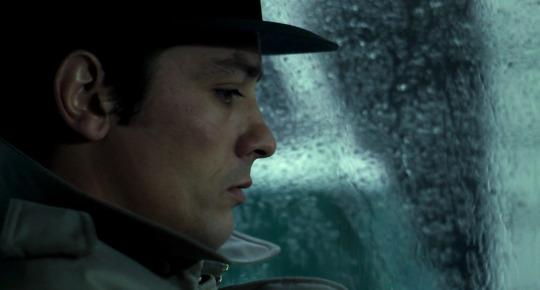
NOIR ALLEY with FNF prez Eddie Muller will be on hiatus during the first two weeks of March due to TCM’s 31 Days of Oscar 2024. The show will return with Eddie on March 16. He will be presenting Jean-Pierre Melville’s Le Samouraï (1967) starring Alain Delon.
Check out the FNF's TV listings page to see all the noirs playing on TCM this month: https://www.filmnoirfoundation.org/news-tv.html
#noir alley#tcm#tv listings#eddie muller#film noir foundation#le samouraï#alain delon#jean pierre melville
17 notes
·
View notes
Text
So, I was thinking about media literacy today. Yeah, totally normal thing to be thinking about. Anyways, I was thinking about how a person's level of media literacy changes how they perceive a film. The example film I was considering was Blade Runner.
If someone has basically no media literacy, they get some cool visuals and a movie with a detective guy shooting robots. Perfectly enjoyable film.
A little bit of media literacy, and we start picking up on cool little details. For example, where do we meet Deckard? A noodle shop. That's an odd choice for an American movie, right? If it'd been made in the 50s, the film would start in a diner over a plate of fried eggs and greasy bacon. The noodle shop isn't presented as this kitschy quirky place, either, it's presented with the utter banality of the mundane diner. But, aha, the film was made in the 80s, when Americans were worried that Japan was going to economically and culturally eclipse America, and the noodle shop supplanting the diner is a symptom of that fear.
We also see the visual elements of noir almost immediately. Besides just being an element for a detective story, this is a hint. In noir flicks, the protagonist doesn't always win, and when he does, it never seems to look like what either the character or the audience thought winning was going to look like. The audience is being told something right from the start: this might be sci-fi but it ain't Star Wars, motherfucker, so pay attention.
Let's get deeper. More media literacy, and what do we notice? Themes of "Other"ing a group literally made by the ones doing the Othering, fear mongering of this evil group of inhuman things that want to infiltrate society and do evil inhuman things, everyone should be afraid of the scary replicants! They're so inhuman that it.... takes a highly skilled expert with extremely specialized and sensitive equipment to tell they aren't human.
Hmm.
It goes further, though. What is it that Roy Batty was after? What did he want when he confronted his creator? He wanted to live, the most basic and gene-deep desire of not just humans, but every living thing. That was the great sin of this group of inhuman Others. They wanted to live. In the Tears In The Rain monolog, we see the surrender to nihilism in the face of death, the lament that none of these incredible things that Roy had seen will be remembered.
Consider the end. The man whose entire purpose was to hunt down and kill these inhuman Others runs off with one of them. They don't know how long they'll have, but they know it won't be long. Rachel has maybe a few years, but she and Deckard are going to the other great conclusion of nihilism. If nothing matters, then live without regrets. Grab what you can while you can, because no one makes it out alive in the long run.
So yeah. Am I late to the party on that bit, or do I have something here?
(As a side note, I think it might be one of the earliest examples of the great question at the heart of cyberpunk: what is "human"? It's as foundational to the genre as "who did it" is to the detective movie. The big bad inhuman Other is almost entirely indistinguishable from human. Even got the same basic motives.)
28 notes
·
View notes
Photo

I am VERY remiss in not reminding you fine folks that there’s another Noir City out in the world (and has been for a while). Sitting like a filling in a mouth of otherwise perfect teeth is my wee piece on Stanley Baker, so if you’re interested, go subscribe here. If you’re not, you should still subscribe, because there’s plenty of good stuff in store.
1 note
·
View note
Text
People think the MOCK in mockumentary is means like mockery and thus only tend to attribute the term to comedic films, but it's actually a Mock Documentary, meaning not a real documentary. In the same way a mock turtle soup has no turtle in it.
With this knowledge pseudo-documentary is a vestigial genre name that should be phased out.
This intended artifice is why found footage and mockumentaries are often lumped together, but they are lovers entangled together for their whole lives. And Analogue Horror is their offspring.
And their great progenitor is Cinéma vérité documentaries.
This is a similar filmic evolution that takes us from Noir to Slasher films.
And like found footage and mockumentary goes way farther back than Cannibal Holocaust (1980). The Connection (1961) appears to be the earliest? Though Nanook of the North (1922) counts as well.
I believe the 5 films pictured to be the foundational pieces, but I am open to input

The reason something like Nanook of the North (1922) doesn't find itself as a foundational piece is because it for a long, long time it was considered just a documentary. But the origins of the film hews closer to mockumentary without actually being a foundational block of the genre.
So with The Connection (1961) the found footage film is truly born and from then until Blair Witch Project (1999) there are a few dozen films prior but the first wave crests here in 1999. After Blair Witch Project there is a glut of similar films and past films being to get appreciated. I like to refer to this as The First Wave of Found Footage.
The Second Wave comes with Paranormal Activity and after the democratization (mostly) of every step of the production and distribution process there has been a consistent deluge of found footage films.
I think this rise of Analogue Horror is the beginnings of a Third Wave.
Anyway, I have read exactly 0 books on the genre. I have literally just formed all this in my brainpan over the last decade. I know there two very good books about the genre that I should check out and I will soon.
11 notes
·
View notes
Text
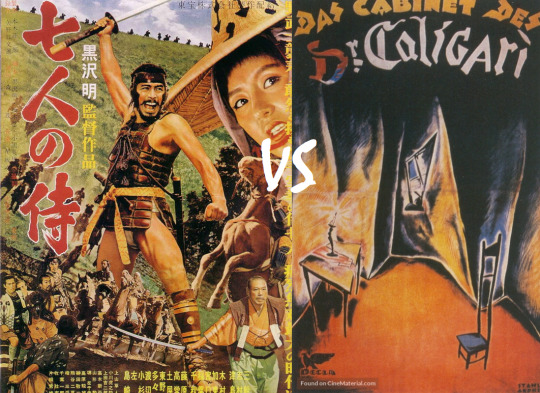
Seven Samourais:
What can even be said? Directed by the visionary Akira Kurosawa, who pioneered many of the most foundational filmmaking techniques used to this day. The film is exciting and compelling, every shot is art, and its legacy on the industry is yet to be overshadowed. It consistently makes top ten on ‘best films of all time’ lists to this day, rated the best foreign language film of all time by the BBC. All the actors are great, Toshiro Mifune is hot, the soundtrack by Fumio Hayasaka is iconic, and the film was technically magnificent for the time, with the techniques and effects frankly still blowing many modern blockbusters out of the water (ahem. marvel.) The film is also one of the most remade and reimagined films to date. Particularly of note is that The Magnificent Seven, one of the most famous films of all time (and criminally much more well-known than Seven Samurai) is explicitly a direct remake of Seven Samurai with the setting swapped. Frankly it’s no contest. All of Kurosawa’s films are brilliant, and were massively influential for their own reasons, but Seven Samurai is such a seminal piece of cinematic history that not including it would be nigh a crime.
Seven rōnin are hired to protect a village from bandits. This film has such a classic set-up and has been remade several times over (See: The Magnificent Seven, The Invincible Six, A Bug's Life honestly...). However, I personally think the original did it best. It's got the best action, the best characters (Toshiro Mifune my beloved), and just the best general direction. For a film that's over 3 hours, not a second of it feels wasted.
The Cabinet of Dr. Caligari:
Arguably the first TRUE horror film! The Cabinet of Dr. Caligari is a majorly influential German silent film from 1920, very easily streamed all over the place including YouTube! It had a tremendous impact on German and American cinema, especially in horror and later noir films, and featured fantastical elements of surrealism in its depictions and architecture that are incredibly endearing. The film is a tale of love, hypnotism, and murder. Fantastic plot twist for an early film, and Cesare is very very gender.
11 notes
·
View notes